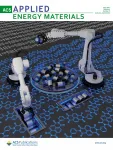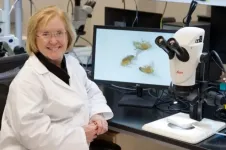(Press-News.org) Cells are the building blocks of life, present in every living organism. But how similar do you think your cells are to a mouse? A fish? A worm?
Comparing cell types in different species across the tree of life can help biologists understand how cell types arose and how they have adapted to the functional needs of different life forms. This has been of increasing interest to evolutionary biologists in recent years because new technology now allows sequencing and identifying all cells throughout whole organisms. "There's essentially a wave in the scientific community to classify all types of cells in a wide variety of different organisms," explained Bo Wang, an assistant professor of bioengineering at Stanford University.
In response to this opportunity, Wang's lab developed an algorithm to link similar cell types across evolutionary distances. Their method, detailed in a paper published May 4 in eLife, is designed to compare cell types in different species.
For their research, the team used seven species to compare 21 different pairings and were able to identify cell types present in all species along with their similarities and differences.
Comparing cell types
According to Alexander Tarashansky, a graduate student in bioengineering who works in Wang's laboratory, the idea to create the algorithm came when Wang walked into the lab one day and asked him if he could analyze cell-type datasets from two different worms the lab studies at the same time.
"I was struck by how stark the differences are between them," said Tarashansky, who was lead author of the paper and is a Stanford Bio-X Interdisciplinary Fellow. "We thought that they should have similar cell types, but when we try analyzing them using standard techniques, the method doesn't recognize them as being similar."
He wondered if it was a problem with the technique or if the cell types were just too different to match across species. Tarashansky then began working on the algorithm to better match cell types across species.
"Let's say I want to compare a sponge to a human," said Tarashansky. "It's really not clear which sponge gene corresponds to which human gene because as organisms evolve, genes duplicate, they change, they duplicate again. And so now you have one gene in the sponge that may be related to many genes in humans."
Instead of trying to find a one-to-one gene match like previous methods for data matching, the researchers' mapping method matches the one gene in the sponge to all potentially corresponding human genes. Then the algorithm proceeds to figure out which is the right one.
Tarashansky says trying to find only one-to-one gene pairs has limited scientists looking to map cell types in the past. "I think the main innovation here is that we account for features that have changed over the course of hundreds of millions of years of evolution for long-range comparisons."
"How can we use the ever-evolving genes to recognize the same cell type that are also constantly changing in different species?" Said Wang, who is senior author of the paper. "Evolution has been understood using genes and organismal traits, I think we are now at an exciting turning point to bridge the scales by looking at how cells evolve."
Filling in the tree of life
Using their mapping approach, the team discovered a number of conserved genes and cell type families across species.
Tarashansky said a highlight of the research was when they were comparing stem cells between two very different flatworms.
"The fact that we did find one-to-one matches in their stem cell populations was really exciting," he said. "I think that basically unlocked a lot of new and exciting information about how stem cells look inside a parasitic flatworm that infects hundreds of millions of people all over the world."
The results of the team's mapping also suggest there's a strong conservation of characteristics of neurons and muscle cells from very simple animal types, such as sponges, to more complex mammals like mice and humans.
"That really suggests those cell types arose very early on in animal evolution," Wang said.
Now that the team has built the tool for cell comparison, researchers can continue to collect data on a wide variety of species for analysis. As more datasets from more species are collected and compared, biologists will be able to trace the trajectory of cell types in different organisms and the ability to recognize novel cell types will improve.
"If you only have sponges and then worms and you're missing everything in between, it's hard to know how the sponge cell types evolved or how their ancestors have diversified into sponges and worms," said Tarashansky. "We want to fill in as many nodes along the tree of life as possible to be able to facilitate this type of evolutionary analysis and transfer of knowledge across species."
INFORMATION:
Additional Stanford co-authors include graduate students Margarita Khariton and Pengyang Li, and Stephen Quake, the Lee Otterson Professor of Bioengineering and professor of applied physics and co-president of the Chan Zuckerberg Biohub. Other co-authors are from the European Molecular Biology Laboratory and the University of Heidelberg. Wang is also a member of Stanford Bio-X and the Wu Tsai Neurosciences Institute. Quake is also a member of Bio-X, the Stanford Cardiovascular Institute, the Stanford Cancer Institute and the Wu Tsai Neurosciences Institute.
This research was funded by Stanford Bio-X, a Beckman Young Investigator Award and the National Institutes of Health. Wang and Quake will be building on this work as part of the Wu Tsai Neurosciences Institute-funded Neuro-Omics Initiative.
A new study finds that fly ash--particles left over from burning coal--make up between 37 and 72 percent of all particulate organic carbon carried by the Yangtze River in China, or around 200,000 to 400,000 tons of carbon per year.
The study, which is the first of its kind, shows just how big an impact fossil fuel consumption has on Earth. Beyond pumping carbon dioxide into the atmosphere, coal burning dumps about as much particulate carbon into the Yangtze River as natural processes do.
The findings were published in the Proceedings of the National Academy of Sciences (PNAS) on May 17.
"About one-fifth of the world's coal consumption occurs along this river," says Gen Li, postdoctoral ...
A new report by Skoltech scientists and their colleagues describes an organic material for the new generation of energy storage devices, which structure follows an elegant molecular design principle. It has recently been published in ACS Applied Energy Materials and made the cover of the journal.
While the modern world relies on energy storage devices more and more heavily, it is becoming increasingly important to implement sustainable battery technologies that are friendlier to the environment, are easy to dispose, rely on abundant elements only, and are cheap. Organic batteries are desirable ...
East Hanover, NJ. May 25, 2021. A team of experts in post-stroke neurorehabilitation confirmed that including prism adaptation treatment in standard of care for patients with post-stroke spatial neglect improved functional and cognitive outcomes according to the Functional Independence Measure®. The article, "Prism Adaptation Treatment Improves Inpatient Rehabilitation Outcome in Individuals with Spatial Neglect: A Retrospective Matched Control Study" (doi: 10.1016/j.arrct.2021.100130.
was published in Archives of Rehabilitation Research and Clinical Translation on May XX, 2021. It is available open access at https://www.sciencedirect.com/science/article/pii/S2590109521000343
The ...
LED lightbulbs offer considerable advantages over other types of lighting. Being more efficient, they require much less electricity to operate. They do not give off unwanted heat the way old-school incandescent bulbs do, and the best of them long outlast even fluorescent lightbulbs.
But LEDs are not problem-free. Questions linger over suspected links between health concerns such as fatigue, mood disorders, and insomnia from overexposure to the blue-tinted light produced by today's standard LED bulbs. Plus, higher prices can prompt lightbulb shoppers to weigh other options.
A University of Houston research team led by Jakoah Brgoch, associate professor of chemistry in the College of Natural Sciences and Mathematics and principal investigator in the Texas Center for ...
ITHACA, N.Y. - It stands to reason that the more one is compensated for performing a task, the greater the incentive to do a good job and the better one feels about doing it.
But what if the task is writing an objective review of a company or service? Does the compensation blur the lines of objectivity?
Kaitlin Woolley, assistant professor of marketing in the Samuel Curtis Johnson Graduate School of Management, Cornell SC Johnson College of Business, wondered the same thing.
"You often receive emails after a purchase, offering you a chance to win a gift card to the company in ...
One in five women experience pain during intercourse. The latest edition of the Diagnostic and Statistical Manual of Mental Disorders, the bible of American psychiatrists, lists it under "genito-pelvic pain or penetration disorder." However, this type of pain is not purely psychological.
Provoked vestibulodynia is a condition experienced by approximately 8% of women in North America. It is characterized by severe pain at the vaginal opening during sexual intercourse or when inserting tampons. To reduce the burning sensation, many women apply lidocaine, an anesthetic ...
Boston, MA-- How does the switch to a high-deductible health plan affect children with asthma? A new study led by researchers at the Harvard Pilgrim Health Care Institute suggests that enrollment in a high-deductible health plan (HDHP) may not be associated with changes in asthma medication use or asthma exacerbations when medications are exempt from the deductible. The findings were published in JAMA Pediatrics on May 10.
To treat asthma, clinical guidelines recommend the use of controller medications, but adherence to these medications is generally suboptimal, putting those affected at risk for asthma exacerbations. High out-of-pocket costs have been associated with decreased controller medication use and adverse asthma outcomes for children and adults. ...
The energy available from sunlight is 10,000 times more than what is needed to supply the world's energy demands. Sunlight has two main properties that are useful in the design of renewable energy systems. The first is the amount power falling on a fixed area, like the ground or a person's roof. This quantity varies with the time of day and the season. The second property is the colors or spectrum of the sunlight.
One way to capture solar energy is to use solar cells that directly turn sunlight into electricity. In a solar module like those that people place on their roof, many cells are assembled on a rigid panel, connected to one another, sealed, and covered ...
New research from the Clemson University Center for Human Genetics has identified specific cell clusters in the brain of the common fruit fly affected by acute cocaine exposure, potentially laying the groundwork for the development of drugs to treat or prevent addiction in humans.
While cocaine's neurological effects are well known, the underlying genetic sensitivity to the drug's effects is not. In human populations, susceptibility to the effects of cocaine varies due to both environmental and genetic factors, making it challenging to study. Approximately 70 percent of genes in the fruit fly, Drosophila melanogaster, have human counterparts, providing researchers with a comparable model when studying ...
BOSTON -- A multidisciplinary team from MassGeneral Hospital for Children (MGHfC), Brigham and Women's Hospital and other institutions have identified the mechanism of how an extremely rare but serious post-COVID-19 complication develops in children and adolescents. Led by MGHfC pediatric pulmonologist Lael Yonker, MD, researchers determined that viral particles remaining in the gut long after an initial COVID-19 infection can travel into the bloodstream, instigating the condition called Multisystem Inflammatory Syndrome in Children (MIS-C).
The syndrome can occur several weeks after an initial infection; symptoms include high fever, abdominal pain, vomiting, diarrhea, rash and extreme fatigue. The hyperinflammatory ...



